
 Interview
Interview


![]() Part 1: Managing Noh as a business
Part 1: Managing Noh as a business
![]() Part 2: Ensuring the survival of Noh (for future generations)
Part 2: Ensuring the survival of Noh (for future generations)
Interviewer: Kinue Oshima (Noh actor of the Kita School)
Photography: Shigeyoshi Ohi
Part 2: Ensuring the survival of Noh (for future generations)
Humiliating first overseas performance: what I learned from my first foreign performance
Oshima: What was your impression of the response of foreign audiences when you performed overseas?
Hosho: My first overseas performance was at Expo 2015, a universal exposition hosted by Milan, Italy. I had a large number of understudy roles at the time and didn’t think I had the leisure to go overseas, but I received a call from a certain producer and participated, having decided after endless agonizing, that I should have the experience at least once, and it was a complete disaster.
This relates to two points I raised earlier. The first is that I failed because there was no unified purpose. There was a category that introduced both traditional and modern Japanese culture, but no one was willing to captain the show. We proceeded without any clear notion as to what we were wanting to convey with the result that the noh performance was greeted with total bewilderment by the audience. The bafflement was agonizing and my humiliation was so great that I had tears in my eyes mid-performance. I could understand it if it’s something we’d prepared for but I was simply told to perform my art, so to be on the receiving end of such treatment was mortifying. There was nothing I could do though, as all I’d come with was my noh. I realized that for an overseas performance to be successful it was necessary to set goals, assume captaincy and draw up a complete program for the event.
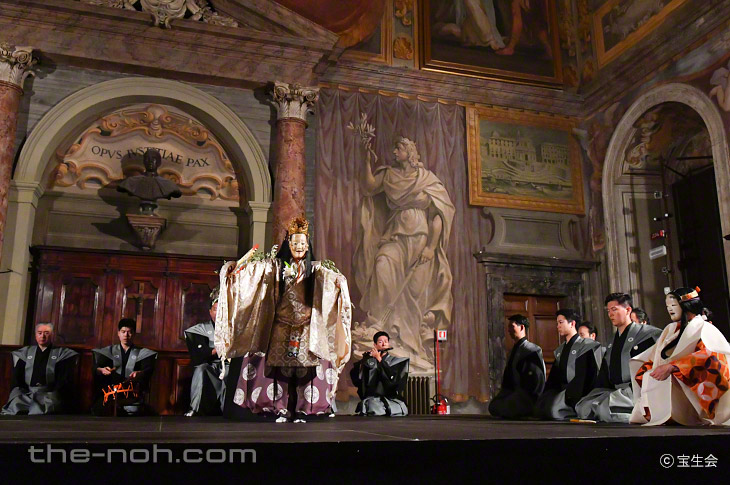
From a performance of “The Resurrection of Christ” held at the Palazzo della Cancelleria in June 2017 to celebrate the 75th anniversary of diplomatic relations between Japan and the Vatican. This play, performed by the Hōshō school, is the only Noh play to derive directly from the theme of Christian tradition. Created in 1957 by Kurō Hōshō, the 17th Grand Master of the Hōshō School, on the basis of a work by German missionary Hermann Heuvers, this play has long been treated as lost, but was revived in the Holy See, the headquarters of the Catholic religion. Here we see Kazufusa Hōshō in the shite role of Christ.
Oshima: Oh, I didn’t know that.
Hosho: The other thing that I realized is that the things that we as noh performers are trying to convey and the methods we use to do so become more difficult to translate when seen through the filter of a third-party producer. Noh theater groups are quite capable of putting forward solid proposals, but I’ve known such proposals be rejected with just one additional filter in the mix. We needed the communication skills to be able to convey what it was we were attempting to achieve and what we were capable of doing.
I’m involved in an overseas performance project that aims to establish a network of contacts in a specific country. Since it’s no easy matter to rebuild connections if they’re severed, there’s even less room for failure than with performances here in Japan. More people vowing never to see noh again would be fatal for the noh theater community. Accordingly, talking to event directors, extending invitations to other art directors, providing space for negotiation and laying the foundations for future business is a process that I’ve learned an enormous amount from. I’m also deeply grateful to all these individuals for giving us the opportunity to stage performances that cannot fail.
Oshima: It’s all about gaining a firm foothold, is it not?
Hosho: That’s right. I also believe that lumping all foreigners together into a single category is a misguided approach. The French and the Italians, for example, have completely different perspectives on the world. Speaking personally, I was more prepared to work with Italians at this stage. It goes without saying that I would naturally accept a request to perform in another country but I don’t think I’d be any good at it. By contrast, I’m giving feedback to the Italians from various perspectives in the hope that they’ll tell me eventually that all the necessary information is in place.
Without that, we risk losing the individual character of the various styles of noh performance. I’d rather have foreign audiences learn that particular styles are specific to particular regions than simply be able to say that we’ve performed everywhere without attempting to showcase the different schools of noh.
Oshima: That’s an interesting new perspective, though your interest in performing elsewhere might be piqued were you to make friends around the world!
Excitement is mounting here ahead of the Olympics and Japan is expected to welcome large numbers of foreign visitors. Will you be doing anything in connection with this event?
Hosho: Japanese theater is underdeveloped. I go to theater performances when I’m overseas because I want to study foreign theater, but I’m not interested in seeing performances that are aimed at foreigners. I think English language commentary services are a good idea, but focusing exclusively on incoming tourists has the potential to miscarry and could merely serve to alienate them.
Many foreign visitors to Japan want to experience the daily lives of Japanese people. That being the case, our goal should be to have these visitors see noh in an everyday context, to have programs that include regularly scheduled performances that everyone, foreign visitors included, is welcome to attend. As far as I’m concerned, it’s nonsense to categorize performances as being exclusively for “inbound tourists”.
Oshima: I agree. Rather than simply having special planned events, we should be aiming for performance schedules that Japanese people, too, will naturally feel inclined to attend. It’s as you say, the noh theater community should be working to cultivate that kind of breeding ground for regular patrons of the noh theater too.
A scrap-and-build mentality acquired through games
Oshima: You’re taking a break from WANOKAI, the theater group you presided over, aren’t you? By all accounts, you were committed to doing this a decade after the theater group was inaugurated. What led you to that decision?
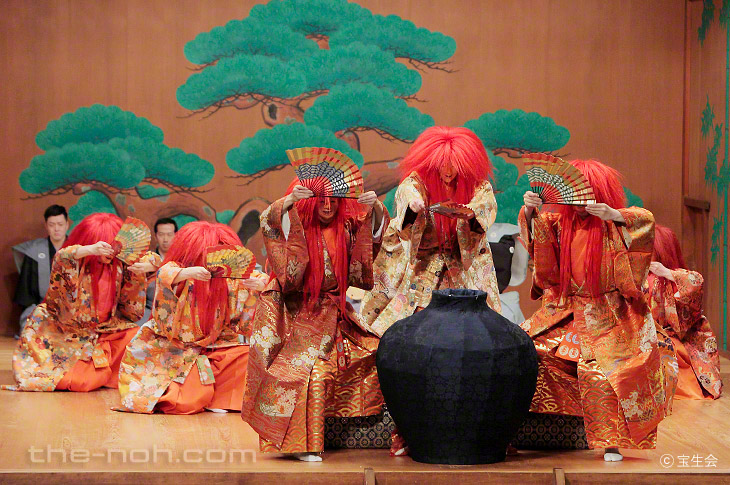
WANOKAI, the collaborative project involving artists from various genres that took “experiencing Noh” as its subject and was presided over by Kazufusa Hōshō. Held in 2018, the grand finale was a special performance of “Shichinin Shōjō”, featuring seven Shōjō protagonists, for atruly opulent final performance.
Hosho: Let’s see. For me, the issue was one of becoming “habituated”, shall we say. With WANOKAI, my goal was to take the risk of changing the theater group members from year to year, but the team I was working with became increasingly inflexible. I’d come up with new business models but, mindful of these members, was unable to bring them to fruition.
I need an opportunity to create a flatter organization, I think, but even if you start from scratch, there’s still experience and knowhow and connections you can draw on, so I think it’s important to have the courage to take the next step knowing that it’s impossible to level the playing field completely.
Truth be told, I developed this sensibility from playing online mobile games. I used to play the game Ragnarok Online when I was in high school and there was a beta version that allowed you to play under test conditions. Some games are commercialized from the beta version without modification meaning that (test user) data can be carried straight over, but for some reason this wasn’t the case with Ragnarok. My first thought on discovering this was: “Why do I have to relinquish everything that I’ve built up so far? Do I have to start all over again?”, but one of my friends told me: “You’re not starting from scratch. You know the sequence and you have the knowhow to maneuver through the game; use that and you’ll be able to do things you couldn’t do before, won’t you?” I realized he was right and found new perspectives and new ways to enjoy the game using the skills I’d acquired playing the beta version.
Oshima: You take lessons from everything, don’t you (laughs). Speaking of which, I haven’t tried these yet, but I understand you’re involved in the development of a glasses-type wearable terminal. Apparently, wearers will be able to view commentary on scenes and characters that are superimposed onto their field of vision in real time as they watch a performance.
Hosho: Someone was one step ahead of me on this one. We’re using the Sony SmartEyeglass as opposed to the Epson product. In all honesty, this being a proposal from a noh performer the communication proved really difficult, but I learned valuable lessons from this too.
I’ve tried various different commentary devices. Earphone guides block the ears, which is stressful when you’re trying to listen to the noh chants and it’s also difficult to sift through the information that’s available. With seat monitors I found my gaze dropping to the monitor and missed the performance completely. There’s definitely room for improvement with both these devices and I came up with various ideas – like bone conduction, for example, but I realized I wouldn’t be able to create an original device due to the rights issues involved.
Wearable devices were thus the option I elected to go with. As a gadget-lover, I’m still not completely satisfied with what’s out there, but information on new technology is coming through thick and fast and the company we’re working with is proving extremely flexible. I definitely think the devices need to be smarter. They’re still a little over-exaggerated and a little difficult to operate. I’d like them to evolve to a level where you can put them on like regular glasses, but the process of trial-and-error needed to get to that point is interesting in and of itself. By rights, service is offering a product once it’s been perfected and I don’t think we’re anywhere close to that yet, but I’m not in an executive position to make exaggerated claims like that now, am I? (Laughs) Even a beta version could prove useable. It goes without saying that I’d be happy to shift to another technology if something more interesting came along. It’s a challenge I’m truly excited to be tackling.
Oshima: Your clearly stated objective of aiming for “better things” must surely help with the selection process. Given the range of options available, there’s a great deal to look forward to, too.
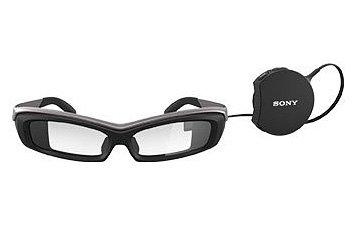
Sony’s wearable augmented reality device, the “SmartEyeglass”. The augmented reality system jointly developed by Dai Nippon Printing and Hōshō Noh Theater, displays commentary that follows the content of performances.
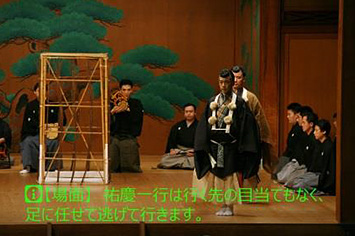
Images projected onto the Sony SmartEyeglass. Explanations of the characters, hayashikata (the instrumental performers) and jiutai (the chorus of performers that sing the verses to certain Noh sequences) as they appear, and commentary on set changes and movements make it easy to grasp the essence of the story. Subtitles are displayed under the main field of vision so as not to fog the stage or interrupt the viewer’s theater-going experience.
It’s less about straining to leave a legacy, more about producing results
Oshima: I haven’t yet congratulated you on the birth of your son. He’ll be about 14 months old now, I think.
Hosho: That’s very kind of you. Thank you, and yes, he’s 14 months old now.
Oshima: I have a nephew who’s about the same age. They’re at that adorable age when they’re just beginning to talk. You’ve said that you’re still developing yourself, but is there anything you’d like to communicate to the next generation or your own children?
Hosho: I still have so much on my own plate that there’s really nothing of any significance for me to say, but to embark hand-in-hand on a process of transforming resolute failures into something remarkable has generated unheard of ideas for the Hosho noh theater. I’d like to give everyone the freedom to move, to make an impression even if indirectly.
As to my child, I really have nothing to give. Japan was at the height of its economic bubble when I was growing up and every year I travelled overseas, flying first class and staying in hotel suites. I thought that lifestyle would go on forever, but it ended abruptly when my father collapsed. I can remember thinking that life really is a castle in the sand. That even the most robust of sand castles is destined to crumble because it’s built on sand. I realized, too, that it’s not about what you leave behind but about what you create. As I said earlier, even if you level the playing field, you leave behind the experience and information you’ve “created”. Ultimately, it’s enough to leave something behind, rather than driving oneself to the limit in an attempt to leave a legacy. If you feel the urge to exert a little needless pressure, then getting younger actors to aspire to perform like the current iemoto is probably enough. It would be good if that produced more aspiring noh actors and if anything, my role as head of the family wouldn’t be worth doing without that level of enthusiasm.
Oshima: It sounds to me as if these are convictions that have grown from your upbringing. I think many of us now struggle to turn our mistakes into valuable life lessons, things that we can use as the basis for our livelihoods. This could well be because we’re not very good at interpreting the world around us. When I visit schools in the regions, emotional problems are something that frequently come up in conversation with the teachers there. I’ve often thought that using noh theater to help discipline the mind would be a good idea. Is there anything else you would like to convey to our readers? A message perhaps.
Hosho: I’m not very good at giving messages, really (laughs). Let’s see, though. To be perfectly honest, my goal is not to popularize noh theater per se. “Popularization” is something you can only really talk about with the benefit of hindsight. My feeling is that if we can create value for noh theater then its popularity will naturally increase. For me, though, it’s less about that and more about the nature of the value we are seeking to create. I’d like, for example, to develop a style that gives audiences the freedom to drop in to a performance on a Friday evening rather than feeling that a visit to the noh theater is something one must steel oneself for on a weekend. I think that incorporating noh into one’s lifestyle as a means of calming the mind, of giving oneself the time to react to events and so on that have occurred over the past month or week even, has the potential to improve work styles, too. I’d like to succeed in making noh a force for change in society rather than simply achieving popularity for this performance art.
Oshima: I understand that the final performance of WANOKAI was promoted as an informal event that audiences were invited to view in the same way as they’d visit an exhibition of paintings at an art museum, but I think this could tempt those who view a visit to the noh theater as being an out-of-the-ordinary event into going to a performance, don’t you?
Hosho: That idea came to me when I realized that a trip to the theater resembled the way in which non-Japanese use art museums. Unfortunately, museum culture has yet to take root in Japan. I don’t doubt that there are some people for whom this isn’t the case, but people generally only gather for special exhibitions. It saddens me to think that for the majority of people art museums are only of interest for the special exhibitions they host.
I also think we need to consider the primary role of shrines and temples. To view shrines and temples simply as theaters, as places to view performances (of noh theater), or as places for the staging of events seems to me to be a bit of a shame. The medieval stone churches of Finland, for example, serve as landmarks as well as places of worship. Noh theaters should be celebrated as places where one can feel the presence of the divine, as places that create value from their role as both stage and place of worship. Theater audiences are in decline and a precedent needs to be set if we are to slow this trend and ensure the survival of performing arts. This is a job that needs to be undertaken by us as the next generation of actors/performers.
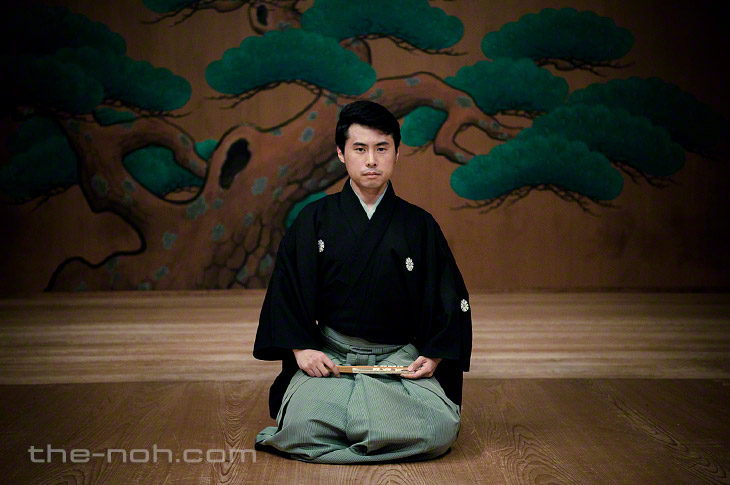
The future of noh lies in questioning the teachings of our predecessors
Hosho: As I see it, the problems facing noh theater today can be traced back to the Meiji era, when attempts were made to pattern noh after opera. The aim of modern-day opera performances as entertainment is very different to that of noh. Opera also differs from noh in that performances are created for audiences of thousands, whereas our performances are created with audiences of five to six hundred people in mind.
Oshima: It’s true that noh theater as a style didn’t exist before the Meiji era.
Hosho: That’s right. Moreover, the noh theater continued to introduce new methods with every new era, with every change in the administration. It really only stopped innovating in the Showa era.
In my opinion, to accept on faith the teachings of our predecessors is to do them a serious discourtesy. To question is to bring the teachings to life. According to the kabalistic school of thought, religion only comes to life when one questions the very existence of God. To get back to our original topic, the greatest respect we can pay to our predecessors is to give serious consideration as to whether what they did was genuinely valid. The biggest insult we can give them is to take their words as being beyond doubt and use them as teachings. There was a period during which “Noguchi recitations” were seen as the epitome of the Hosho school, but this subtle and profound style of performance was established by Kanesuke Noguchi (1879-1953; a shite-kata actor of the Hosho school who is held to be one of the major figures in the history of noh). To understand the implications of that, you need to ask why he established that mode of recitation and whether, in doing so, he accomplished all there was to accomplish. Noguchi didn’t set out to chant with a harsh voice; the loss of his voice was one of the major turning points in his life. But for an actor to deliberately destroy a good voice for that reason would be a grave mistake.
Oshima: This harks back to something you mentioned earlier, to thinking about the hidden meanings of words, to what one is really seeking to communicate, I think.
Hosho: Actor Mansai Nomura has been named as the chief executive creative director overseeing the opening and closing ceremonies for the Tokyo 2020 Olympic and Paralympic Games and the noh community is very excited about this turn of events. That’s not, however, to say that the support of everybody within the community will necessarily produce good things. This will be a gathering of individuals who all have very different ideas so finding a style that facilitates cooperation will be essential to reaching agreement on how to proceed. The creation of a hero demands its antithesis in the same way that the sun cannot exist without the moon. The time will come when it becomes impossible for all of the five noh schools to continue. All of us, the Hosho school included, would do well to understand that we’re in the process of being winnowed down, make no mistake about it. Even were we to work with agencies, for example, those agencies might be professional but they are professional in the entertainment industry, not in the world of noh. Accordingly, we’re going to need to do our homework if we want to be able to communicate with these people as equals, either by blocking all information until its fully developed or by incorporating various different things and panning for gold.
Oshima: That will be no easy task, that’s for certain.
Hosho: Ultimately, the family heads will need to take responsibility, even if that opens up the possibility of one’s own demise. It’s a point on which the Kita school has been very clear, I understand.
Oshima: That’s not something I can comment on, I’m afraid (laughs). Your situation is different, but I’m sure the Hosho school is committed to doing its best.
Hosho: I’m entering into an agreement with Tatsunori Kongo, the young head of the Kongo school. This forging of a pact between different schools is unprecedented. Ultimately, I’d like to compose something with the Kanze school. Now that really would produce interesting results.
Oshima: I see. You have a secret ambition, then (laughs).
Hosho: We’re not on bad terms, by any means, but an element of “friendly rivalry” is essential. It would be wonderful if our compatriots in the noh community were to take an interest in that concept. I’m not one to admit defeat, mind. I’m also a fan of giant killing (unexpected upsets). I’d like to line shoulders with first-rate performers, but to do that requires preparation and the ability to view things with a level head.
Oshima: That may mean asking for instruction from the leading figures, too; you with your spirit of rebellion… It will certainly be very interesting to see how ravenous is your hunger for success.
Hosho: I’m definitely willing to give it a go, though not at the expense of anyone else, I hope (laughs).
Oshima: True, indeed (laughs). This has been a stimulating and highly educational conversation. Thank you. (End of Part 2)
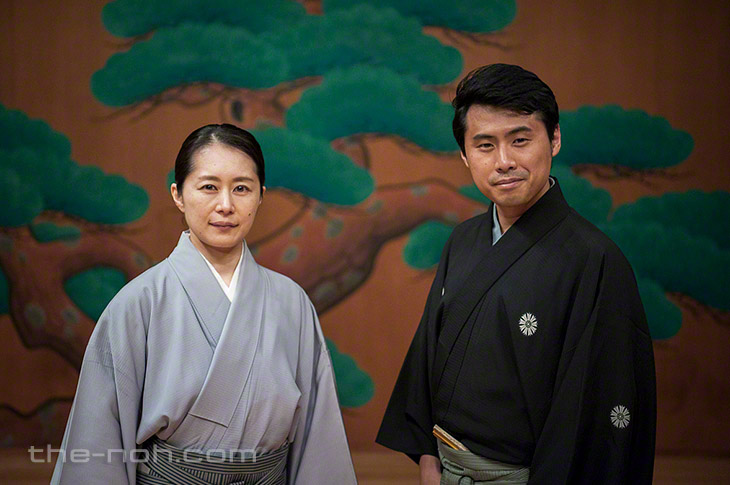
Kazufusa Hosho, 20th Grand Master of the Hosho School (宝生和英)
Hosho was born into the Hosho household in 1986, an illustrious school of Noh performers that dates back to the Muromachi era. He made his stage debut in 1991 as a kokata (juvenile actor) in Seiōbo (Queen Mother of the West). He became head of the Hosho School in April 2008 following his graduation from the Department of Traditional Japanese Music at Tokyo University of the Arts. In October that year, he set up WANOKAI with a group of volunteers in sympathy with his ideas about Noh, an organization he presided over until its grand finale in 2018. Whilst Hosho is keen to safeguard traditional performances, he also strives to collaborate with other industries and plays an energetic managerial role in his attempt to find ways of creating new value for Noh. Hosho performs throughout Japan and is working to expand his cultural horizons overseas, mainly in Italy.
Interviewer: Kinue Oshima (大島衣恵)
Oshima is a shite-kata actor of the Kita School and a member of the Nohgaku Performers’ Association. She also teaches part-time at Elisabeth University of Music. She was born in Tokyo in 1974 and moved to the city of Fukuyama in Hiroshima Prefecture at the age of two, in wich year she made her stage debut as the Chigo (child of festivity) in Kurama Tengu (Long-nosed Goblin in Kurama. She studied under her grandfather, Hisami Oshima (3rd generation head of the Oshima School) and her father, Masanobu (4th generation head). In 1988, she became the first female actor of the Kita School to perform on stage. She has subsequently joined a number of overseas performing tours and in 2005 was awarded the Hiroshima Prefecture Culture Award. Oshima received the Hiroshima Prefectural Encouragement Award for Education in 2007, was awarded the Encouragement Award for International Exchange by the Hiroshima International Cultural Foundation in 2010, and in 2018 was given the Hiroshima Culture Award by the Hiroshima Foundation for Cultural Promotion.


